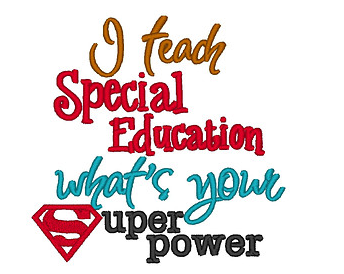Lesson 11: Interventions and Instructional Strategies for Supporting Young Children with Special Needs
Attention

Learning Outcomes
Upon completion of this lesson's material, students will be able
- Identify the terms “ routine-based intervention”, “play-based intervention”, and “activity-based intervention”.
- Define “active engagement” when referring to young children in an inclusive learning environment.
- Describe three environmental arrangements that contribute to a child’s engagement in an inclusive setting.
- Define the term “prompt” and give 3 examples of prompts.
- Define & explain the term “embedded instruction”
Teaching
What is engagement and why is it important?
Engagement is defined as a child’s sustained attention, active involvement with the people (teachers parents, classmates), activities (snack time, play time, group-time participation center selection/participation), and materials (use of toys, art supplies, water-play materials) throughout the child's day that lead to goal achievement (Cook, Brotherson, Weigel, & Erwin, 2008; Wolery, 2005). One of the least intrusive steps that an early childhood special educators can take to promote engagement of children within their educational setting is to carefully arrange the physical environment. Materials should be safe, multidimensional, and developmentally appropriate for the children within the learning environment. Infants or toddlers who have easy access to every toy may have a decreased need for communicating or socializing within their environments.
How to promote acceptance
- Create and prepare the social environment to be more accepting of a child with a disability
- Use active and independent activities that involve children with delays or disabilities
- Use cooperative activities, stories, and guided discussions that highlight similarities as opposed to differences.
- Select books that emphasize similarities as opposed to differences and disabilities
Using prompts Prompts are defined as any assistance given or help given by another person (adult) to assist young children in knowing how to make a desired response or behavior. Direct verbal prompts; model prompts; partial or full physical prompts; spatial prompts; visual/pictorial prompts; cued prompts
Interventions & Strategies
Peer-Mediated Strategies are a collection of procedures which involve the use of peers to promote the learning and behavior of a child with disabilities. Examples of peer-mediated strategies Examples of peer-mediated strategies
- Teach selected classmates specific ways to engage their peers with disabilities
- Encourage classmates to persist in their attempts with children with disabilities
- Provide structured opportunities for the children to interact with one another (so as to use the skills taught)
- Provide support (reinforcement and prompts by teachers) during the structured opportunities.
Routine-Based Intervention (Strategies) Take advantage of already occurring events such as play (Linder, 2008), predictable routine activities such as snack time, diapering, circle time and transitions Teachers and parents need to understand that daily activities that have a specific purpose (snack time is for eating) can also serve as an instructional time.
Play-Based Intervention Play is a logical and natural activity for incorporating skills of children with disabilities. Play provides an avenue for children to master their thoughts and actions, and contributes to the child's cognitive, physical, and social/emotional development. Linder (2008) has developed play-based interventions (strategies) for incorporating and promoting skill in the play arena. When setting up activities, it is important to provide a range of difficulty in order to support active engagement.
Activity-Based Intervention Pretti-Frontczak and Bricker(2004) define activity-based intervention as "a child directed transactional approach where multiple learning activities are embedded into authentic activities and logically occurring antecedents and timely feedback are provided to ensure functional and generative skills are acquired and used by children."
- Uses the child's interest while addressing goals and objectives in routine planned or child-initiated activities
- Excellent strategy for infants and toddlers whose objectives can be embedded into daily routine activities at home and at center-based programs
- Children with motor or communication delays who utilize forms of assistive technology in the home or classroom can benefit from an activity-based approach.
NOW, for an activity to demonstrate what this all means...
- Go to CONNECT Modules—FPG Child Development Institute , University of North Carolina, Human Development Institute, University of Kentucky
- Complete Module 1 in the CONNECT Module series—Embedded Interventions. You will proceed through the five steps: the dilemma, question, evidence, decision, and evaluation.
- Complete the entire module, including Summary and Wrap Up.
Please read this summary of the joint position statement of the Division for Early Childhood (DEC) and National Association for the Education of Young Children (NAEYC) on Early Childhood Inclusion.
Assessment
Lesson 11 Quiz
- ___________is one of the least intrusive steps that a teacher can take to promote engagement of children within their educational settings.
- ________________ are simple statements that provide support for a child in his or her current task.
- ___________, which can be verbal or gestural or a combination of the two, supply the child with the desired behavior.
- For ________________ to be successful, early childhood special educators and parents need to understand that daily activities that have a specific purpose can also serve as an instructional time.
- ________________ is an approach that utilizes a transdisciplinary model whereby all service providers and parents observe and assess the child during play.
- _______________ instruction utilizes the child's interest while addressing goals and objectives in routine, planned, or child-initiated activities.
- Materials should be safe, multidimensional, and developmentally appropriate for the children within the learning environment. True or False
- Define prompt and give 3 examples of prompts.
- Define active engagement and provide three examples of a child's engagement.
- Briefly define embedded instruction.
Lesson 11 Discussion
- How can teachers arrange the environment to encourage engagement for all children? Provide three examples.
- In 1-2 paragraphs, summarize your thoughts on peer-mediated strategies.
- What did you think about the CONNECT Module—was it beneficial? Why or why not?